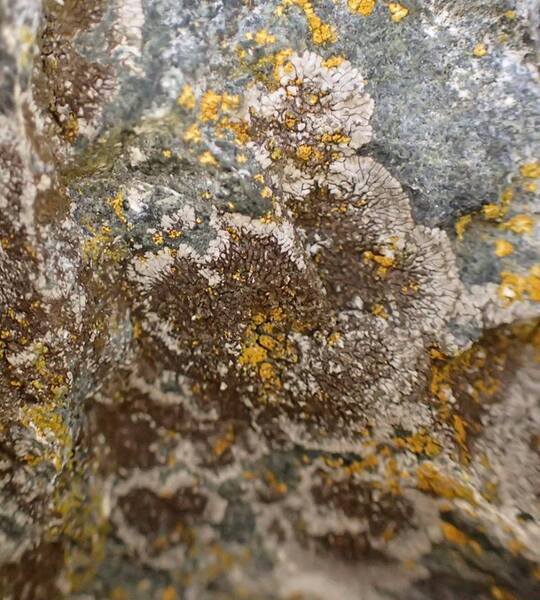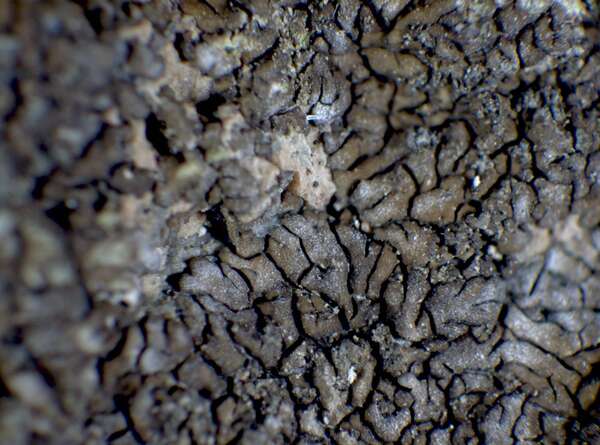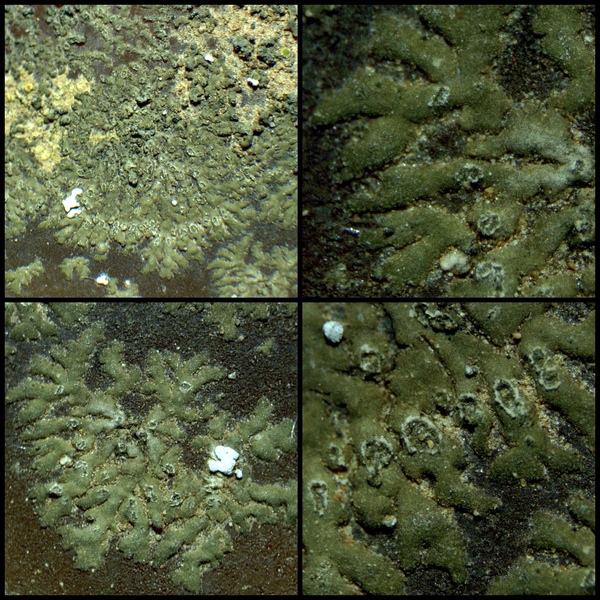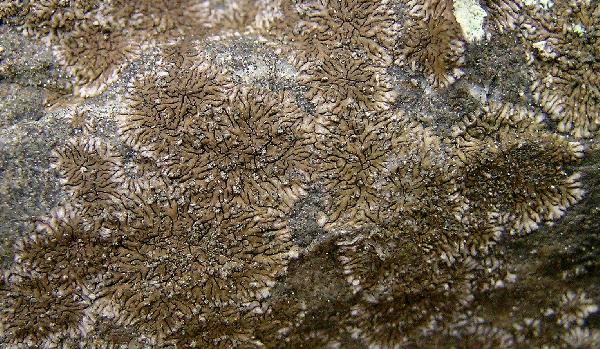Olegblumia demissa (Flot. ex Körb.) S.Y. Kondr., Lőkös, Jung Kim, A.S. Kondr., S.O. Oh & Hur
in Kondratyuk & al., Index Fungorum, 466: 1, 2020. Basionym: Imbricaria demissa Flot. ex Körb. - Syst. Lich. Germ.: 80, 1855
Synonyms: Caloplaca demissa (Körb.) Arup & Grube; Lecanora demissa (“Flot.”) Zahlbr.; Lecanora incusa (Flot.) Vain.; Rinodina castanoplaca (Nyl.) H. Olivier; Squamaria elaeina var. saxicola Beltr.
Distribution: N - Ven, TAA, Lomb, Piem (Valcuvia 2002, 2002b), VA (Piervittori & Isocrono 1999). C - Tosc, Laz, Sar (Nöske 2000). S - Si (Herb. Vondrák 10758).
Description: Thallus crustose-placodioid, episubstratic, firmly attached, pale to dark brown to almost black in sunny situations, often greyish-pruinose in central parts, up to 0.15 mm thick, forming regular to irregular, up to 1 cm wide rosettes, several thalli often merging to cover larger surfaces. Lobes 1-1.5(-2) mm long, (0.1-)0.3-0.5(-0.8) mm wide, flat to weakly convex, divided into 2-3 secondary lobules towards the tips. Soralia mainly in the centre of thallus, laminal, at first punctiform, then irregularly rounded, concave, 0.3-0.5 mm wide, finally sometimes elongated and fissure-like, brownish to brownish green, those in the central parts of thallus often coalescing. Soredia 30-50 μm thick, becoming blastidiate-isidioid, grey-brown to dark brown or brownish green. Cortex 30-40 µm thick, with a brown pigment which dissolves in K forming colourless crystals; medulla white, prosoplectenchymatous. Apothecia not known. Pycnidia rare. Conidia bacilliform to narrowly ellipsoid, 3.5-5 × c. 1 µm. Photobiont chlorococcoid. Spot tests: cortex and medulla K-, C-, KC-, P-, UV-. Chemistry: thallus with vicanicin and caloploicin.Note: a mild-temperate to xeric subtropical species found on steeply inclined to rain-sheltered surfaces of basic siliceous rocks, both in dry-warm Alpine valleys and in the Mediterranean belt; much less bound to water seepage than Peltula euploca and ecologically related species. The species, known only as sterile, earlier positioned in the Lecanoraceae, in the genera Lecanora and Placolecanora, because of its general appearance, has a quite remote position in the Teloschistaceae (Frolov & al. 2020).
Growth form: Crustose placodiomorph
Substrata: rocks
Photobiont: green algae other than Trentepohlia
Reproductive strategy: mainly asexual, by soredia, or soredia-like structures (e.g. blastidia)
Subcontinental: restricted to areas with a dry-subcontinental climate (e.g. dry Alpine valleys, parts of Mediterranean Italy)
On otherwise dry surfaces with short periods of water seepage after rain
Commonnes-rarity: (info)
Alpine belt: absent
Subalpine belt: absent
Oromediterranean belt: very rare
Montane belt: extremely rare
Submediterranean belt: extremely rare
Padanian area: absent
Humid submediterranean belt: very rare
Humid mediterranean belt: rare
Dry mediterranean belt: rather rare
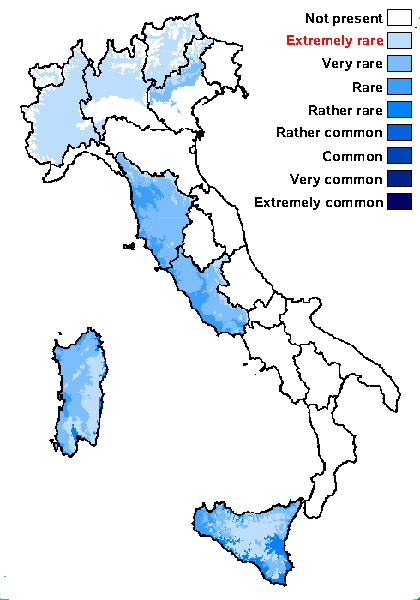
Predictive model
Herbarium samples
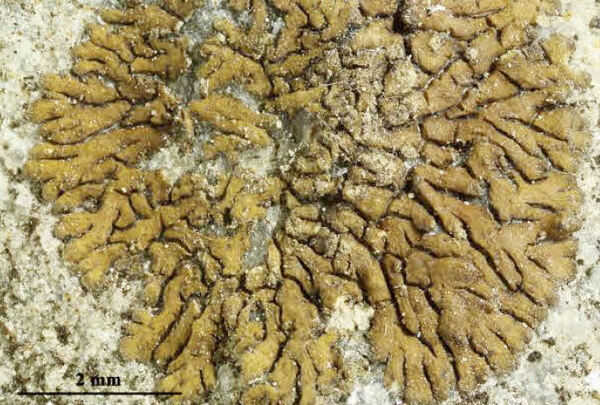

Felix Schumm CC BY-SA 4.0
Korea, Prov. Gangwon-do, beside Maengbang beach, around Mt. Deokbong-san, Hamaengbang-ri, Gundeok-myeoun, Samcheok city, 37°23’19.57’’ N, 129°14’21.23’’ E, 4-10 m, on rocks.
Leg. K.H. Moon (14694) and H. Kashiwadani.
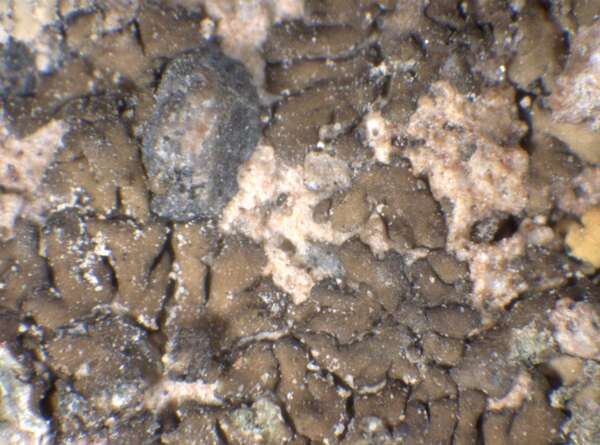

P.L. Nimis; Owner: Department of Life Sciences, University of Trieste
Herbarium: TSB (10065)
2002/05/17
Growth form: Crustose placodiomorph
Substrata: rocks
Photobiont: green algae other than Trentepohlia
Reproductive strategy: mainly asexual, by soredia, or soredia-like structures (e.g. blastidia)
Subcontinental: restricted to areas with a dry-subcontinental climate (e.g. dry Alpine valleys, parts of Mediterranean Italy)
On otherwise dry surfaces with short periods of water seepage after rain
Commonnes-rarity: (info)
Alpine belt: absent
Subalpine belt: absent
Oromediterranean belt: very rare
Montane belt: extremely rare
Submediterranean belt: extremely rare
Padanian area: absent
Humid submediterranean belt: very rare
Humid mediterranean belt: rare
Dry mediterranean belt: rather rare

Predictive model
| Herbarium samples |


Felix Schumm CC BY-SA 4.0
Korea, Prov. Gangwon-do, beside Maengbang beach, around Mt. Deokbong-san, Hamaengbang-ri, Gundeok-myeoun, Samcheok city, 37°23’19.57’’ N, 129°14’21.23’’ E, 4-10 m, on rocks.
Leg. K.H. Moon (14694) and H. Kashiwadani.


 INDEX FUNGORUM
INDEX FUNGORUM
 GBIF
GBIF
 DOLICHENS
DOLICHENS
